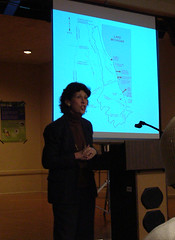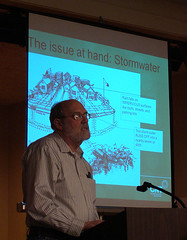The other day I went to a talk in Rogers Park, part of a new series put on by the 49th Ward Green Corps.
Of the three speakers, I found most interesting the talk by Debra Shore, one of the commissioners of the Metropolitan Water Reclamation District, which manages fresh and wastewater in the greater Chicago area.
In her talk, Shore said that since the reversal of the Chicago River in 1900, over 30 trillion gallons of Lake Michigan water have been diverted out of its watershed down the Illinois River. There are locks controlling the mouth of the river so most of the drainage does not come directly from the lake, but flows through the piping of the city. Living next to such a huge body of water, most Chicagoans take fresh water for granted. The Great Lakes hold 20% of the fresh water on earth, and 90% of the fresh water in the U.S. so much that it seems unlimited.
But global warming forecasts predict less rainfall in the midwest, and as the Great Lakes states lose population to booming Sun Belt cities, local governments are already planning ahead to a day when outsiders may attempt to exploit our fresh water. Under an agreement by the Council of Great Lakes Governors, no state or province bordering the Lakes is allowed to take water outside of the watershed of the Lakes. But that is exactly what happens in Chicago. Over 900 million gallons of fresh water are pulled in each day from Lake Michigan, are used by citizens, then flow through treatment plants to end up the Chicago River and drain out of the natural watershed. Even rainwater which falls on the city runs into storm drains which connect to the sewage system, or stored in the Deep Tunnel and eventually pumped to the same treatment plants and sent away.
At this point there are no plans to reverse the flow of wastewater flowing south out of the city, but there are many things that can be done to reduce the amount of water that needs to be taken from the lake, and the Water Reclamation District is working on some of these, though without much funding.
M8 million gallons a day are lost from illegal fire hydrant use. Perhaps 78 million gallons a day are lost through leaking pipes. In a city with hundreds of miles of aging, deteriorating water mains, pipe replacement barely keeps up.
Another plan to reduce the amount of water sent downstream is to keep storm and rain water out of the system by green engineering approaches. Bill Eyring of the Center for Neighborhood Technology spoke about rain gardens and bioswales, small garden depressions which can temporarily store runoff from rooftops and parking lots, allowing it to soak into the ground naturally and return to Lake Michigan or the local water table instead of running into the sewage system.
Any storm water that can be drained away naturally instead of through the overloaded sewage system also avoids another nasty combined sewage outflow incident like the one we saw up close last summer, when raw sewage floods backwards into the river. And any rain water that that returns to Lake Michigan will help keep the lake as the amazing place it should be.

